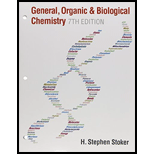
Concept explainers
(a)
Interpretation: To determine the number of phosphoanhydride bonds present in an ATP molecule.
Concept introduction: Phosphoanhydride bond is the bond between the two phosphate groups. During the phosphoanhydride bond formation, a water molecule is released and phosphates groups are connected to each other. General representation of the phosphoanhydride bond is as follows:

(b)
Interpretation: To determine the number of phosphoester bonds present in an ATP molecule.
Concept introduction: Phosphoester bond is the

Want to see the full answer?
Check out a sample textbook solution
Chapter 23 Solutions
Bundle: General, Organic, and Biological Chemistry, 7th + OWLv2 Quick Prep for General Chemistry, 4 terms (24 months) Printed Access Card
- Which of the following compounds would you expect to liberate the least free energy when hydrolyzed? Explain. a. ATP b. ADP c. AMP d. phosphoenolpyruvate e. phosphocreatinearrow_forwardWhich one of the following buffers the concentration of ATP? Select one: a. Glycolysis b. Acidosis O c. Phosphocreatine O d. Oxidative phosphorylation e. Acetyl coenzyme Aarrow_forwardWhich of the following processes would be directly affected by the presence of a non-hydrolyzable form of ATP ? the depolymerization of tubulin monomers O the depolymerization of actin monomers the polymerization of tubulin monomers the polymerization of actin monomersarrow_forward
- Draw the complete molecular structure of the hydrolysis of a phosphate from ATP. Give the value and units of AG for the reaction.arrow_forwardWhich of the following correctly describes the linkages found in ATP? two anhydrides, a phospho ester and a glycosidic bond two anhydrides, two phospho esters and a glycosidic bond three anhydrides, a phospho ester and a glycosidic bond one anhydride, two esters and a glycosidic bondarrow_forwardWhich one of the following statement is CORRECT for ATP? Select one: a. Divalent cation Cl2- stabilize ATP and blocks the driving force for association and make ATP unstable. O b. Phosphate bonds of ATP is "highly transferable" bonds. O c. ATP is very unstable in salt solutions having near neutral pH therefore spontaneously dissociate into ADP and Pi. O d. In pure water ATP is very stable and high water concentration would only drive this reaction forward with the help of enzyme.arrow_forward
- What are the common structural characteristics of ATP and DNA molecules? In what ways these are different?arrow_forwardExergonic reactions such as the breakdown of ATP, are said to be “spontaneous.” However, by themselves, even exergonic reactions often proceed very slowly. What part of the curve helps to explain this? WHICH LETTER REPRESENTS IT? Thank you !(:arrow_forwardMagnesium ion (Mg2+) forms complexes with the negative charges of the phosphate in ATP. In the absence of Mg2+, would ATP have more, less, or the same stability as when the ion is present?arrow_forward
 Human Anatomy & Physiology (11th Edition)BiologyISBN:9780134580999Author:Elaine N. Marieb, Katja N. HoehnPublisher:PEARSON
Human Anatomy & Physiology (11th Edition)BiologyISBN:9780134580999Author:Elaine N. Marieb, Katja N. HoehnPublisher:PEARSON Biology 2eBiologyISBN:9781947172517Author:Matthew Douglas, Jung Choi, Mary Ann ClarkPublisher:OpenStax
Biology 2eBiologyISBN:9781947172517Author:Matthew Douglas, Jung Choi, Mary Ann ClarkPublisher:OpenStax Anatomy & PhysiologyBiologyISBN:9781259398629Author:McKinley, Michael P., O'loughlin, Valerie Dean, Bidle, Theresa StouterPublisher:Mcgraw Hill Education,
Anatomy & PhysiologyBiologyISBN:9781259398629Author:McKinley, Michael P., O'loughlin, Valerie Dean, Bidle, Theresa StouterPublisher:Mcgraw Hill Education, Molecular Biology of the Cell (Sixth Edition)BiologyISBN:9780815344322Author:Bruce Alberts, Alexander D. Johnson, Julian Lewis, David Morgan, Martin Raff, Keith Roberts, Peter WalterPublisher:W. W. Norton & Company
Molecular Biology of the Cell (Sixth Edition)BiologyISBN:9780815344322Author:Bruce Alberts, Alexander D. Johnson, Julian Lewis, David Morgan, Martin Raff, Keith Roberts, Peter WalterPublisher:W. W. Norton & Company Laboratory Manual For Human Anatomy & PhysiologyBiologyISBN:9781260159363Author:Martin, Terry R., Prentice-craver, CynthiaPublisher:McGraw-Hill Publishing Co.
Laboratory Manual For Human Anatomy & PhysiologyBiologyISBN:9781260159363Author:Martin, Terry R., Prentice-craver, CynthiaPublisher:McGraw-Hill Publishing Co. Inquiry Into Life (16th Edition)BiologyISBN:9781260231700Author:Sylvia S. Mader, Michael WindelspechtPublisher:McGraw Hill Education
Inquiry Into Life (16th Edition)BiologyISBN:9781260231700Author:Sylvia S. Mader, Michael WindelspechtPublisher:McGraw Hill Education





